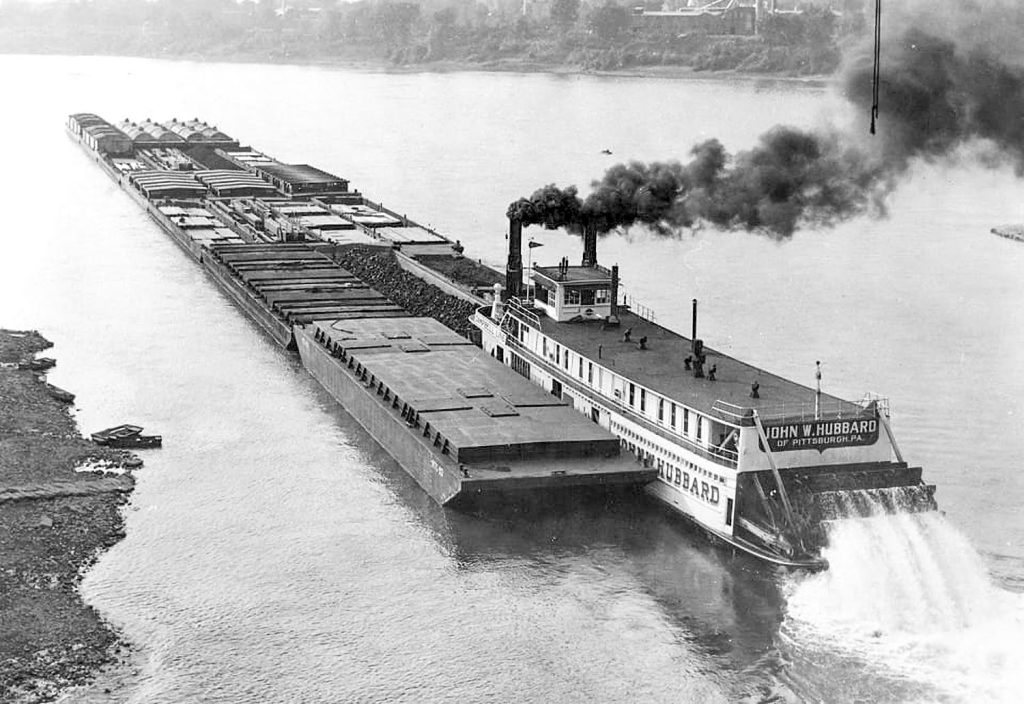In a recent visit with a good friend of nearly 50 years—Capt. William F. “Bill” Judd, a retired marine surveyor from the Cincinnati area—the fact that he had, as a young man, once decked on the steam sternwheel towboat Charles Dorrance came up. That prompted a more in-depth look at the Dorrance, which was among the last of its kind on the Upper Ohio River.
Capt. Charles T. Campbell began Campbell Transportation Company with the acquisition of the steamer Shannopin (Way’s T2292) from J&L Steel in 1931. By 1936, the company had grown significantly. A story in the March 14, 1936, issue of The Waterways Journal, written by the WJ publisher/owner Capt. Donald T. Wright, outlined further expansion planned by Campbell. The boats of the company were regularly operating between Pittsburgh and Memphis and would soon extend the routes to include St. Louis and Wood River. The Carnegie-Illinois steamer Isthmian (T1217) was under charter to Campbell, and two new boats were under construction for them at Dravo, Neville Island, Pa. These would “be the largest in regular operation out of Pittsburgh” when they entered service. The article stated that the company was owned jointly by Capt. Campbell and John W. Hubbard.
Another story, in the April 18, 1936, WJ, said that the first of the new boats had been launched at Dravo on April 16, and it was named John W. Hubbard. John Winslow Hubbard, a Pittsburgh millionaire, was often referred to as the “Shovel King” due to being the head of Hubbard & Company, a manufacturer of shovels, axes and other tools. He had been extensively involved in packet boats on the Ohio River into the waning days of that trade prior to joining forces with Campbell in the towing venture. One packet had been named in his honor. This piece in the WJ indicated that the Campbell Line had also arranged to obtain 10 standard (175- by 26-foot) hopper barges from the Marietta Manufacturing Company (MMC), and three of the same type from Dravo Contracting.
It was announced in the Pittsburgh news column of the May 16 issue of the WJ that Campbell was planning a double ceremony for the new Hubbard as well as the second boat as soon as it was launched, which it was felt would coincide with the Hubbard leaving the shipyard for regular service. The engines for the second boat were nearing completion at the MMC plant at Point Pleasant, W.Va., and were to be delivered to Neville Island in some of the new Campbell barges being built by MMC, along with the new boilers being built by the Acme Boiler works of Gallipolis, Ohio. In the same news column of the June 27 WJ it was reported that Ellis Koontz had been “appointed chief engineer of the steamer John W. Hubbard, now nearing completion at Neville Island.”
A short piece in the July 11 WJ was headlined “New John W. Hubbard on Maiden Trip.” It stated that the boat had left Pittsburgh on July 11 on its first trip to Memphis, and that the machinery “went beyond expectations.” The hull of the new vessel measured 171.5 by 24 feet. The condensing engines were 16’s, 32’s, 8-foot stroke rated 1,000 hp. James A. Wallen noted in his Huntington News column in the July 18, 1936, issue that Capt. Vernon Byrnside was in command of the Hubbard as it passed through the local area on that first trip. Capts. John Dippold and Homer Varian were pilots, and Raymond Robbins was mate. In the August 1 WJ was found a note that the new boat had passed Cairo, Ill., on July 26, upbound on the return leg of the first trip to Memphis. It had two loads and two empties in tow.
Way’s Steam Towboat Directory says that the John W. Hubbard carried the whistle and bell from the packet Queen City (Way’s 4615). The Queen City was built at Cincinnati in 1897 and was a favorite in the Pittsburgh–Cincinnati trade until it ceased operations in 1933 to become a wharfboat at Pittsburgh. Hubbard had owned the Queen City in part or in whole from 1912 to 1933, so it is no strange coincidence that these appurtenances should be placed on the new boat. The large bell had originated on the Anchor Line packet City of St. Louis (1130) of 1883, and the whistle is speculated to have come from the packet Hudson (2678) of 1886.

Masters of the Hubbard in its first decade of operation in addition to Capt. Byrnside were Capts. Al Smith (who had been with the famous Lee Line packets out of Memphis), R.F. “Dusty” Rogers, Charlie Roberts and Andrew Sayre. In 1941, Campbell Transportation was merged into the Mississippi Valley Barge Line and continued operating under the same name. Capt. Vernon Byrnside was with the Valley Line for a time after the merger and would later go to work for Ohio Barge Line before retiring in the late 1960s after bringing the 4,320 hp. towboats Steel Ranger and Steel Trader out new from Dravo. This writer had the pleasure of meeting him when he was still working as a trip pilot in the early 1970s.
In 1947, the Valley Line sold the Hubbard and the sister vessel Charles T. Campbell to The Ohio River Company. It’s unclear exactly when the bell and whistle were removed, but the Queen City whistle went to the steam sternwheel towboat Joe Cook (T1384), built at Nashville in 1930 and operated by Pfaff & Smith Builders Supply Company of Charleston, W.Va., until 1952. The bell was placed on the tourist steamer Delta Queen (1504) when it was rebuilt at Dravo for Western Rivers service in 1947 and remains aboard to this day.
The next column will look at the John W. Hubbard from this point forward.
Caption for top photo: The Str. John W. Hubbard. (David Smith collection)
Capt. David Smith can be contacted at davidsmith1955obc@gmail.com.




